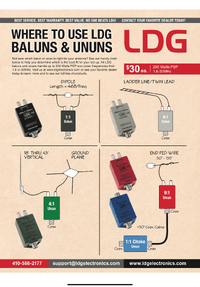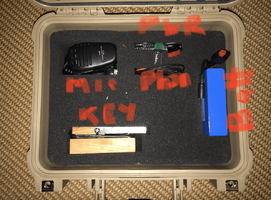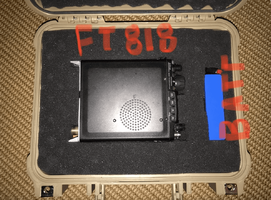Right. I just want to dip my toes in the water first, and decide whether I even want to move forward. I'm taking some baby steps on the learning curve. Just want to get on the air listening for now, and see what others are doing, and how they do it. Don't know my way around any of the frequency or wavelength stuff yet. Just trying to pick up on the lingo and terminology, and a little on what exists nearby my area (Central Mass). I'm certain there are other likeminded people in the area, so maybe we can help one another.
There's a few things here though....
-honestly just pound the question pools till you pass reliably. (use online test generators till you are only getting a couple wrong) Then actually take the test. If you can't commit to doing that, the rest of it is a non starter, and its not that big of a deal. I passed before you could use a computer to generate the tests. this is a committment about maybe 4-8 hrs total depending on how slow someone is upstairs and maybe $15 or whatever the rate is now for a test session.
-People get into radio for different reasons. There's also different motives and personalities on the air as well. It's no different than the archetypes at the range, for that
matter. Amateur radio has its own set of fudds and karens too, but thankfully a lot of those pricks have died off. There are different regimes of operation as well, things like 2M FM can even vary repeater from repeater, but then you have HF operations and all that comes with that, the Clowntesters vs DXers vs ragchewers etc but IMO everyone has their place. (and as annoying as contests are to me, I like them existing because they drive the state of the art on the equipment end especially on hte high end. A lot of the nicer gear ive ever used would not exist if not for contesters.
-Like anything else you're only going to get out of it what you put into it. If you don't have a technical mind or interest in building that skillset you are going to be stunted a little bit. A self starting attitude is necessary probably more now than ever becasue of the increased value of time and the lack of people teaching others how to do stuff. Like when I was a kid through lots of burns and trial and error I learned how to solder a coax connector, but if it wasnt for having other radio-mentor type people arond I wouldnt know things like "in a generic sense, how an AC to DC power supply works" or things like how HF propagation works, or the generic effects of adding capacitance or inductance into an antenna transmission line network to lower the SWR of the whole thing, etc.
I am not the best teacher at a lot of this stuff because I tend to be a pragmatist. I enjoy working the radio or putting parts of a station together more than I do trying to design an antenna or similar. I know what a smith chart is but dont necessarily know how to use it to my advantage, but on the other hand I can hook up something like an MFJ 259 analyzer or similar to an antenna and look at the antenna and the results of what the analyzer is telling me and pretty easily tell you whether you're going to have a great time with that antenna or conversely just feel like ball self punching every time you get on the air.
Also tenancity to some degree is also a requirement. The antennas dont put themselves up. Also RFI isnt just going to go away if thats an issue (mainly these days its more received than
transmitted, f***ing pot grow lamps shattering the bands). Also the difficult thing now is radio requires time. This is one of the reasons its more difficult now than ever for people
to really operate and improve their stations. Because some broad wont leave them alone long enough to do something. Also at some level with some things in radio you have to
sort of get pissed off enough to do something about it. Like for example if I had S9 of noise filling my neighborhood I'd have my mobile set up already and just drive somewhere else when I want to operate. Or get a radio like a 705 and go hike up on a big friggan hill somewhere on a saturday and throw a line into the trees or something. (hilltopping actually can be pretty fun, and can be the less-shit version of QRP, altitude can do a lot to make up for lack of output power in a lot of cases. )
If you find yourself sucked in though, it does keep you
busy. And at least what I call the "back 40" of things is skinflint friendly, although not quite as cheap as it used to be. AKA, building antennas, etc. The gear itself... can last a long assed
time if you make good choices.
There's also a bunch of personality archetypes in amateur radio. I tend to stay away from the boring straight laced hall monitor watching paint dry types but I understand and respect where they come from and can play nice with them doing community service or a traffic net or whatever. But those aren't the dudes I'm going to be having conversations with about things like "that guy you knew that built a 4CX10000 amp just becuase he could, to destroy the a**h***s jamming him" The rebels, the discreet ones with knowledge are often the greatest people you will ever meet or read stuff from. (Like as an example, Rich Measures, may he rest in peace, AG6K.... that man was a god among men WRT amplifiers, and both "amateur and otherwise" amp operators benefited from his knowledge and research on the topic. ) My radio reality is more "big tent". I've been licensed since 1994 but probably spent an equal amount of time on places like 11M outband talking to hams there (sans their calls obviousy, using cb "numbers" or even just a name an a location "hey operator Jim number 39 from Odessa, are you out there?" lol) during peak skywave because they know that 10M basically sucks in terms of participation rate sometimes and they just want to talk with some DX stations. I used to talk daily with a whole bunch of guys from Texas a couple cycles ago, it was great. Booming signals, clean audio. Then there are the scanner and SWL geeks and the like, who often have some tricks of their own up their sleeves wrt monitoring, programming gear, etc. Amataeur radio to me is just one big subsection of the tent, but it provides skills and a base for the rest of it as well.
Sorry for the stream of conciousness but its hard to put into words the whole thing.
I think for me it was when I was interested in like CB stuff and I started hearing DX come in after a big thunderstorm or something. I was like "that f***in guy aint down the street, he's at least 1900 miles away, thats f***ing cool". It was even better when I got my first big kid radios like an HR2510 and then later a Kenwood TS440. Later, it would be setting up a longwire to listen to the same guys chatting on 80M SSB or AM every night.





![ROFL [rofl] [rofl]](/xen/styles/default/xenforo/smilies.vb/013.gif)